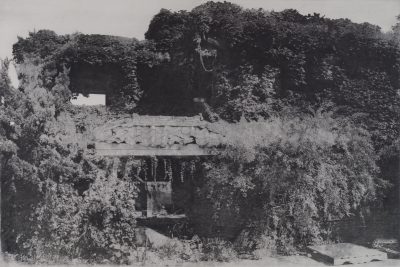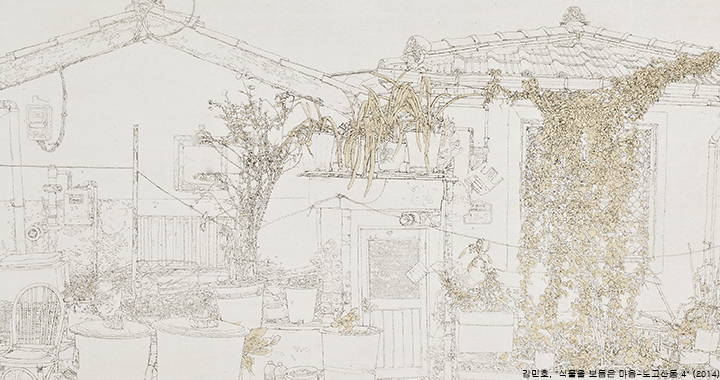김민호 개인전
July 22 – 26, 2020
2020년 7월 22일 – 26일
M Gallery, CICA Museum
도시풍경 에세이
<프롤로그>
이번 전시는 식물을 보듬은 마음 시리즈와 기다리는 집 시리즈로 구성이 되어 있다. 대학 생활부터 현재에 이르기까지 서울에서 살면서 나의 일상에서 가장 많이 마주치고 삶에 영향을 많이 일으킨 ‘동네’에 대한 이야기들이다.
식물을 보듬은 마음 시리즈는 작업실 근처에서 자주 마주치는 풍경에 대한 것으로 집 앞에 빼곡히 늘어져 있는 화분들은 집주인이 식물을 사랑하고 가꾸는 마음을 드러내는 것으로 오래 된 주택가 들에서 볼 수 있는 소소한 풍경들이었다. 이렇게 오래되었지만 사람 사는 냄새가
풍겨오는 따뜻한 동네였고 작업실을 왔다 갔다 하면서 내게 위안을 주는 곳들이었다. 그러나
서울에는 재건축과 재개발이라는 바람이 불게 되었고 그로 인해 작업실이 있던 곳은 사라지게
되었다. 재개발이 되니 월세가 오르고 점점 나는 월세가 저렴한 곳으로 옮겨가게 되었다. 내가
살던 집 근처도 재개발되면서 폐허같이 변하게 되었고 또 이사를 하게 되었다. 그렇게 계속
몇 번을 옮겨 다니는 과정에서 나는 알게 모르게 상처받고 있었고 생활이 변하고 있었다. 그
러면서 발생한 이야기들이 기다리는 집 시리즈이다.
<식물을 보듬은 마음>
대학 졸업 후 오래된 다세대 주택이 많은 동네에 작업실을 구했다. 작업실을 오가며 문득 한 집이 눈에 들어왔다. 빨간 벽돌로 된 조그마한 다세대 주택에는 도저히 화분을 놓기 힘든 곳 까지도 빼곡하게 화분들이 놓여있었다. 옹기종기 모여 있는 화분들의 모습, 그 일상의 풍경은 내게 특별함으로 다가왔다.
도시의 식물들은 대부분 천덕꾸러기 취급받는 일이 다반사다. 거리의 가로수가 간판을 가린다고 하여 무참히 가지를 제거당하고, 빈 땅은 건물을 올리기 바쁘다. 또한, 오래되고 커다란 나무일지라도 거리를 정비하는데 방해가 된다면 지체 없이 베어져 사라진다. 이러한 회색 도시에서 집주변에 식물을 가꾸는 모습, 자연과 함께하며 여유를 갖고 행복하게 살고자 하는 모습이 무척 반가울 수밖에 없었다.
식물을 키우며 산다는 것은 어찌 보면 귀찮은 일이기도 하고 그렇다고 당장 삶에 도움이 되는 것도 아니다. 먹고 사는 문제도 중요하겠지만, 주변도 챙기고 식물도 가꾸는 것은 삶에서 작은 행복을 찾기 위함이고 그것이 결국 삶을 점점 변화시켜가는 작은 움직임이라 느껴졌다. 집과 집 사이에 여백이 없는 좁은 산동네지만 구석구석 화분을 놓고 정성스럽게 가꾸는 아기
자기한 모습은 집주인의 마음을 그대로 드러내고 있다.
‘식물을 보듬는 마음’이라 이름 지은 작업 시리즈는 행복하게 살고자 작은 것부터 실천하는 사람들의 마음을 정성스럽게 표현하며 드러내는 나만의 실천인 셈이다.
<기다리는 집>
‘이제는 거의 다 떠나 빈집들만 보이고 고요한 가운데 한쪽에서 긴장감이 흐른다.
사진을 찍던 나는 어디선가 들려오는 고함에 깜짝 놀란다. 멀리서 누군가 살기 어린 눈매로 노려보며 빨리 나가라고 한다. 당황한 나는 재빨리 자리를 뜬다. 계속 사진 찍고 돌아다녔다간 무슨 일을 당할지 모른다.’
이대 앞 아현동부터 염리동으로 이어지는 동네에 재개발이 진행되면서 수십 년간 살아온 동네 사람들은 거의 다 떠났고 제대로 된 보상을 받지 못하거나 개발에 반대하는 사람들 몇몇이 남아 생존을 투쟁하고 있었다.
2002년부터 서울시와 경기도에는 시내 곳곳이 뉴타운 지구로 급격하게 지정되면서 재개발, 재건축 바람이 일었다. 대학 졸업 후 나의 작업실이 있던 곳은 북아현동이었다. 재개발로 인해 노고산동으로 옮겼고, 심지어 그곳도 몇 년 뒤 건물주가 바뀌면서 재건축을 이유로 이사를 하게 되었다. 심지어 최근 정착한 갈현동 작업실 맞은편도 재개발이 시작된다고 한다. 현재 북아현동에 작업실이 있던 건물은 흔적조차 없다. 노고산동은 건물은 남아있으나 주변이 재개발 진행 중이다. 지금 작업실도 언젠가는 없어질 것이다. 내가 서울 생활을 하게 된 이후 겪고 있는 현실의 모습이다.
재개발이 시작되면 이전에 살던 흔적을 남기지 않고 완전히 다른 모습으로 바뀌어 갔다. 건물, 가로수, 화초들, 전신주에 엉킨 전선들, 좁은 골목길, 중턱의 작은 정자, 가파르고 좁은 계단 등 오랜 시간에 걸쳐서 만들어진 겉모습뿐 아니라, 동네가 품고 있는 수많은 이야기마저 남겨지는 것 하나 없이 사라져 무척이나 쓰라리고 아쉬움이 남았다. 나의 20대부터 오늘날까지 일상적으로 마주치는 일이 되어버렸다. 이러한 이유로 나의 작업에는 자연스럽게 재개발이라는 현실이 스며들게 되었다.
재개발이 진행되면 사람들은 한둘씩 이사를 나가기 시작한다. 다음으로 가장 먼저 돈이 될 만한 창호나 대문 같은 금속류 등이 뜯어져 없어지고 쓰레기 등 폐기물도 쌓여 나간다. 그러면 동네 분위기는 을씨년스럽다 못해 전쟁이 나서 폐허가 된 것 같이 보여 무섭기까지 하다. 그 이후 신기한 일이 벌어진다. 예부터 사람이 집을 떠나면 마당이나 집터에 개망초나 대나무가 마구 번식한다고 들었다. 사람이 살고 있을 때는 식물이 생활영역에 침범하지는 못한다. 그러나 사람이 떠난 빈 건물에는 식물들이 외부와 내부의 경계를 넘어 집을 점령한다.
미야자키 하야오의 애니메이션 ‘바람계곡의 나우시카’를 보면 독이 가득한 곰팡이들 때문에 인간이 살 수 없는 곳이 되어 있는데 결국에는 곰팡이들이 정화작용을 하고 깨끗한 환경을 다시 만들어 가는 모습을 볼 수 있다. 하야오의 애니메이션을 무척 좋아하는 나에게 재건축이 진행되는 이 기간에 식물들의 역할은 수많은 삶의 이야기와 흔적들에 핀 곰팡이 같이 느껴진다. 건물의 시점에서 보면 이제 마지막 손님을 들인 것 같기도 하다. 이제 앞으로 다시 볼 수 없을 동네의 구석구석 가장 마지막 모습을 담은 것이 이번 작품이다.
재개발이라는 것이 인간사에 당연히 있을 수밖에 없겠지만, 이런 식으로 많은 사람이 살던 동네 몇 개가 모인 드넓은 지역을 완전히 지우고 새로 만드는 일은 우리 역사를 통틀어 전쟁에 버금갈만 하다는 생각이다. 그렇게 엄청난 일들이 아무렇지 않은 척 주변에서 너무 많이벌어지고 있고 그만큼 많은 사람의 삶의 형태를 바꾸는 일이며 커다란 움직임에는 틀림이 없다. 재개발이 이루어지는 과정에서 발생하는 이해충돌과 파괴적인 행위들, 그 거대한 흐름에 여리고 미미한 것들은 어느 순간 새로운 아파트 단지에 파묻혀 잠들어 버렸다. 지금 나의 작업은 그 이야기들에 대한 기록이다.
Cityscape Essay – Artist Note
<Prologue>
This exhibition is composed of a series of ‘The Mind Embracing the Plants’ and a series of ‘The waiting houses’. From college life to the present, these are the stories about “Neighborhood” that lived in Seoul and encountered the most in my daily life and influenced my life a lot.
‘The Mind Embracing the Plants’ was about the scenery often encountered near the art studio, and the pots outspread in front of the house reveal the hearts of the homeowner who loves and cares for the plants. It was such a long time, but it was a warm neighborhood with the smell of human life, and was a place to comfort me as I went back and forth through the artstudio. However, in Seoul, the wind of reconstruction and redevelopment blew up, and the place where the artstudio was located disappeared. Due to the redevelopment, the rent was expensive and I gradually moved to a place where the rent was cheap. The neighborhood where I lived was also redeveloped, turning into demolition and moving. In the process of moving around like that a few times, I was hurting unknowingly and my life was changing. It is a series of ‘The waiting houses’ for stories that have occurred.
< The Mind Embracing the Plants>
After graduating from college, I got an art studio in a neighborhood with many old multi-family houses. A house suddenly came to my eyes as I went to and from the art studio. In a small multi-family house made of red brick, pots were placed even in places where it was hard to place pots. The appearance of the pots gathered, and the scenery of the daily life came to me as a special.
Most of the plants in the city are often treated as city pigeon. The street trees were covered with signbord, so the branches were severely removed, and the empty ground was busy raising buildings. Also, even old and large trees are cut and disappear without delay if they interfere with the maintenance of the street. In this gray city, I couldn’t help but be happy to see the plants growing around the house and to live happily with nature.
Growing plants and living is, in some ways, annoying, and it doesn’t help you live right away. The problem of eating and living may be important, but taking care of the surroundings and planting plants is to find a small happiness in life, and it was felt that it is a small movement that gradually changes lives.
It is a narrow mountain village with no margins between the house and the house, but the charming appearance of carefully planting pots in every corner reveals the owner’s heart.
The work series titled ‘The Mind Embracing the Plants’ is my own practice that expresses and expresses the hearts of those who practice small things to live happily.
<Wating House>
‘Now almost all of them are left, and empty houses are visible, and tension is flowing from one side.
When I was taking pictures, I was amazed at the yelling coming from somewhere. Someone from afar stared at him with a lively eye and asked to go out quickly. Perplexed, I quickly leave. I don’t know what will happen if I keep taking photos and walking around.’
As the redevelopment progressed in the neighborhood from Ahyeon-dong to Yeomni-dong in front of the university, almost all the people who lived for decades left, and some people who did not receive proper compensation or opposed to development remained and struggled to survive.
Since 2002, Seoul and Gyeonggi-do have been rapidly designated as new town districts throughout the city. After graduating from college, my studio was located in Buk Ahyeon-dong. Due to the redevelopment, it was moved to Nogosan-dong, and even there a few years later, the landlord changed and moved to rebuild.
Even across from the recently settled Galhyeon-dong studio, redevelopment begins. Currently, there are no traces of buildings that had a workshop in North Ahyeon-dong. The building remains in Nogosan-dong, but the surrounding area is under redevelopment. The studio will disappear someday. This is the reality I have been experiencing since I was living in Seoul.
When the redevelopment began, it changed to a completely different form without leaving any traces of the previous one. Buildings, trees, flowers, wires entangled in telephone poles, narrow alleyways, small pavilions in the middle, steep and narrow stairs, etc. It was bitter and unfortunate. From my twenties to today, it has become a routine encounter. For this reason, the reality of redevelopment naturally permeated my work.
As the redevelopment progresses, people start moving out one by one. Next, metals such as windows and doors, which may be the first money, are torn off and wastes such as garbage are accumulated. Then, the atmosphere of the town is scary, and it seems scary after the war.
After that, something strange happens. I’ve been told that when a person leaves the house, the forgotten flowers or bamboo will multiply in the yard or home. When a person lives, the plant cannot invade the living area. However, in empty buildings where people leave, plants cross the border between the outside and the inside and occupy the house.
If you look at Hayao Miyazaki’s animation, Nausicaa of the Wind Valley, it is a place where humans cannot live because of the poisonous molds. In the end, you can see the molds purifying and creating a clean environment. During this period of reconstruction for me, who loves Hayao’s animation very much, the role of plants feels like a fungus that has shed many life stories and traces. From the point of view of the building, it seems that the last customer is now. This is the last piece of the neighborhood that will never be seen again.
The redevelopment of course is bound to be in human history, but in this way, it is thought that erasing and recreating a large area of several neighborhoods where many people lived would be comparable to war throughout our history. Too many things are going on around the pretend that nothing is going on, and that’s changing the way many people live, and it’s a big move. Conflicts of interest and destructive acts that occur in the course of redevelopment, the enormous flow, and the insignificant and insignificant things are buried asleep in a new apartment complex. My work now is a record of those stories.

김민호 , “기다리는집 – 북아현동 1” (2018)
